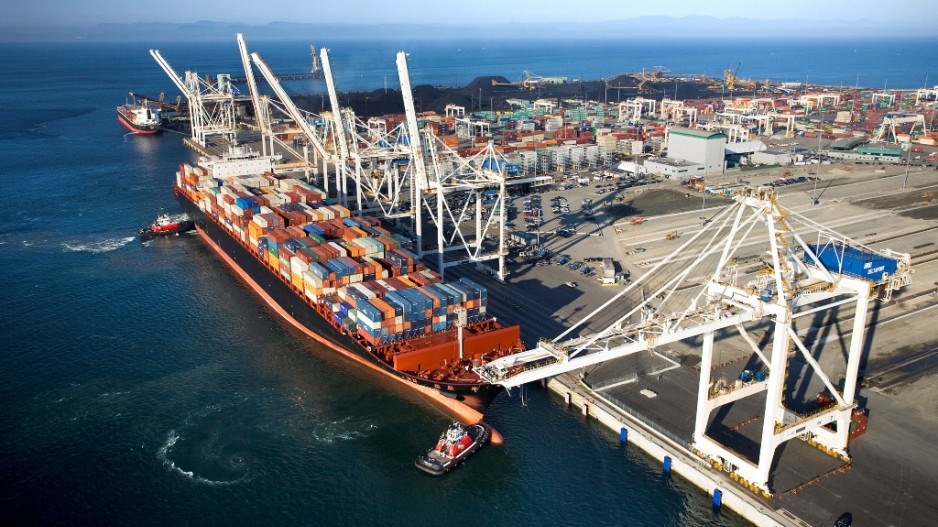Brighter days are forecast in 2017 for global container carriers, but major shipping industry companies in Vancouver are still suffering collateral damage from 2016.
Second-quarter financials at Vancouver’s Seaspan Corp. (NYSE:SSW) showed revenue and profit continuing to take it on the chin, even as the global container-shipping sector shows signs of recovery from one of its worst years on record.
The profit for the world’s largest independent charter owner and manager of container ships was down almost 20% from the US$43.9 million posted in the three months ended June 30, 2016. Revenue also dropped 8.8% to US$204.6 million compared with the same period in 2016 and was down 7.7% to US$405.9 million for 2017’s first six months compared with the same period in 2016.
Reductions in overhead helped offset the lower revenue.
Ship operating costs were cut US$4.4 million, down 9% compared with the same quarter in 2016; general and administration costs were cut US$7.5 million, down 17.4%.
Responding to August 1 earnings conference call questions on cost management, Seaspan chief operating officer Peter Curtis said the reductions were sustainable, but deeper cuts are unlikely because “there’s less and less blood in the stone.”
Seaspan is forecasting third-quarter revenue of between US$209 million and US$213 million.
Apart from updated bottom-line numbers, 2017’s second quarter also ushered in changes in Seaspan’s executive ranks.
Gerry Wang, Seaspan’s chief executive officer and co-founder, announced plans to retire this year after being one of the company’s driving forces for the past 20 years. Wang has worked with Dennis Washington, whose family is Seaspan’s largest shareholder, since 1990.
During the conference call, Wang said the decision to leave was difficult.
“I’m very sentimental. [Seaspan] is my third child, and I’ve devoted all my time, my most precious life, to this franchise.… But after much consideration I decided that the timing is right for both my family and the company. I had extensive communication also with Mr. Dennis Washington, who is really my mentor, and he said one thing that really inspired me. He said, ‘Gerry, take care of your body, because you only have one.’”
David Sokol, who has been appointed chairman of the Seaspan board, said replacing Wang will be a challenge.
“Gerry has been an extraordinary CEO and leader in this business, and that’s always hard to replace. So we’re not going to be in a huge hurry to find [a new] CEO. We want to find the right CEO for the next 20 years.”
Meanwhile, Teekay Corp. (NYSE:TK), which services the global oil and liquefied natural gas sectors, posted a second-quarter loss of US$38 million on revenue of US$514 million compared with a US$700,000 profit on revenue of US$588 million during the same quarter in 2016.
Teekay’s second-quarter loss was attributed in part to lower revenue and ship charter rates reaped by its Teekay Tankers (NYSE:TNK) subsidiary.
Earlier this year, Teekay Tankers became the world’s largest publicly listed shipping tanker company when it merged with Tanker Investments Ltd. (OSLO:TIL). The acquisition added 18 mid-size tankers worth an estimated US$500 million to its 83-ship fleet and created a company with combined assets of US$2.4 billion.
Teekay reported a net loss of US$123.1 million in 2016 compared with profit of US$82.15 million in 2015.
Seaspan, which went public in 2005 with a fleet of 10 container ships, now has a managed fleet of 114 representing a total capacity of 915,000 20-foot equivalent units (TEUs).
It also has significant resources to design, operate and crew container ships.
Along with the rest of the container-shipping industry, it has been struggling with an oversupplied market hobbled by a slowing global economy.
A Danish Ship Finance (DSF) report released earlier this year mapped out little short-term optimism for the container-shipping industry.
Danish Ship Finance Shipping Market Review noted, for example, that shifting demographics in the world’s major economies will continue to retard growth in the container-shipping sector because demand for goods produced in emerging economies is slowing.
That bodes ill for container-shipping lines because, as DSF’s report pointed out, the ability of emerging economies “to create jobs for their growing populations is the single most important prerequisite for future growth in seaborne trade volumes.”
The Copenhagen-based ship financing company consequently described the general outlook for the shipping industry as “bleak.”
But a July 25 container cargo industry outlook from U.K.-based shipping consultancy Drewry painted a brighter picture for the sector.
Highlights of its forecast included a 4% growth in global container-shipping demand for 2017 followed by 3.5% growth in 2018. Those numbers compare with a low of 1% demand growth in 2015.
Drewry analysts said the tide is turning for freight carriers as spot rates are up 50% on trans-pacific routes compared with a year earlier when they sank to record lows.
Drewry pegged average rate increases at 16% in 2017.
As of mid-August, average world container index rates for 40-foot freight containers were up 29% compared with the same time a year ago.
While increased scrapping of container ships has reduced the sector’s capacity glut, Drewry pointed out that many of the new larger vessels being built are due to be delivered in 2018, which would add another 5% to the global fleet of approximately 20 million TEUs and again worsen market overcapacity.
Global shipping data company Alphaliner noted in an August 1 newsletter that vessel scrapping has slowed since April. It estimated that by year’s end the size of the idle container fleet could therefore increase to 950,000 TEUs compared with the current 473,000.
@timothyrenshaw




